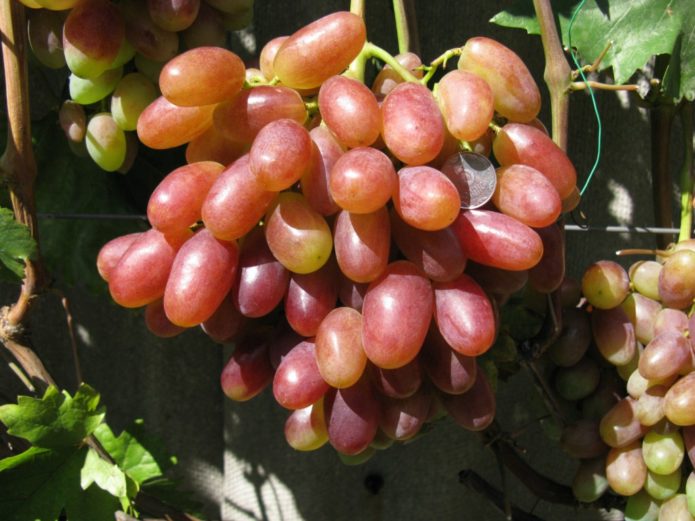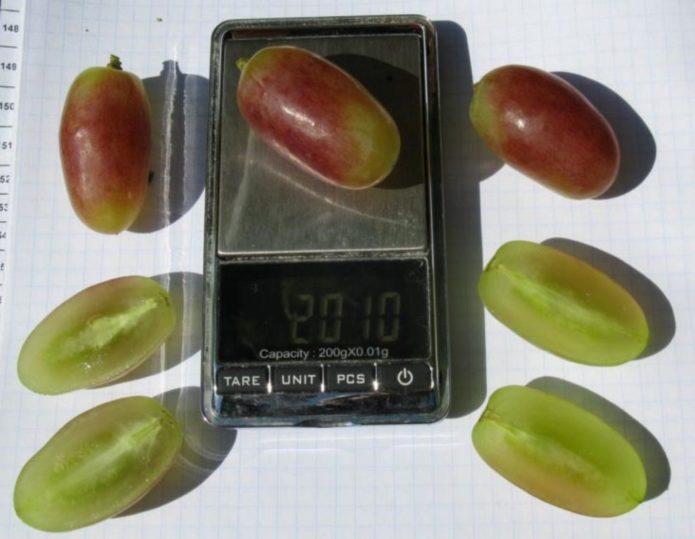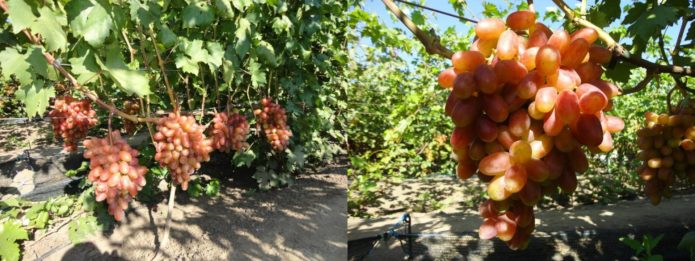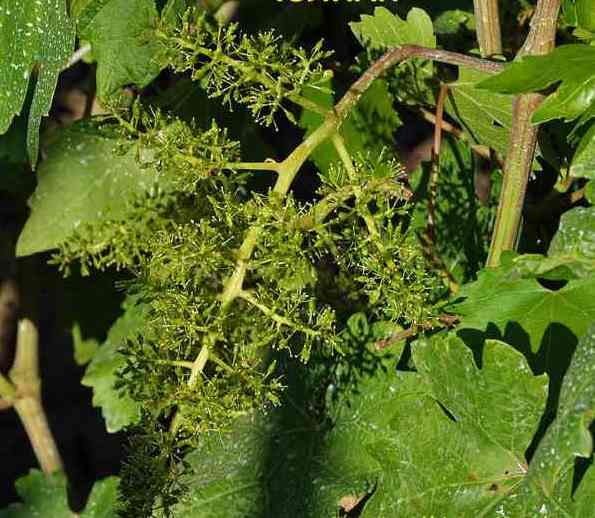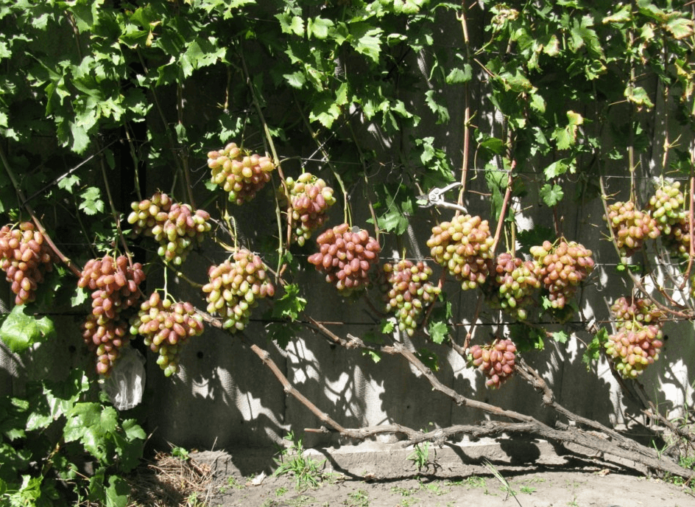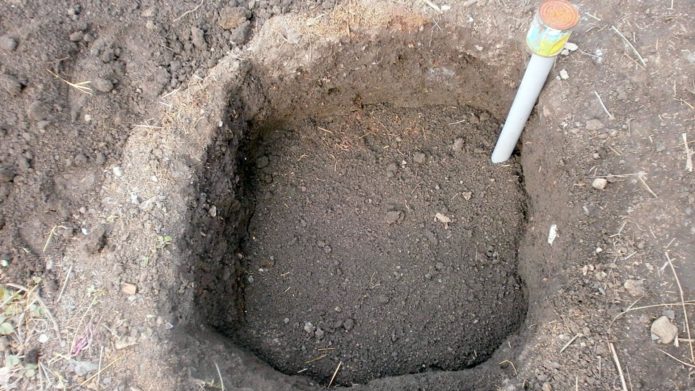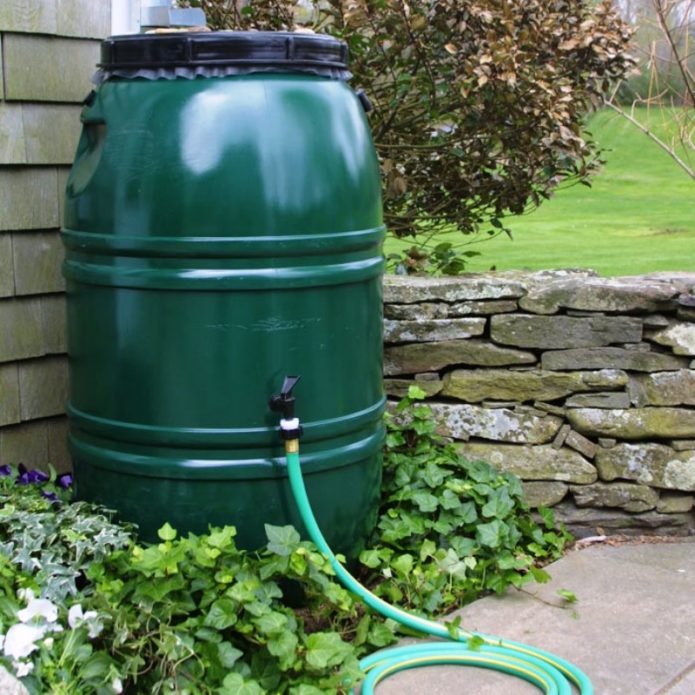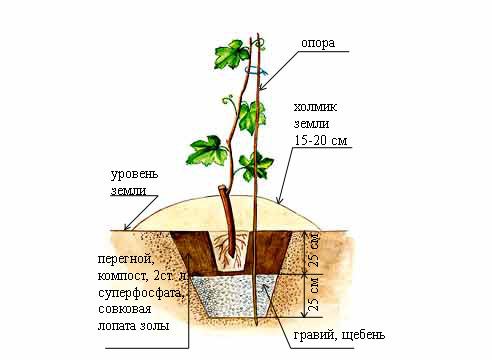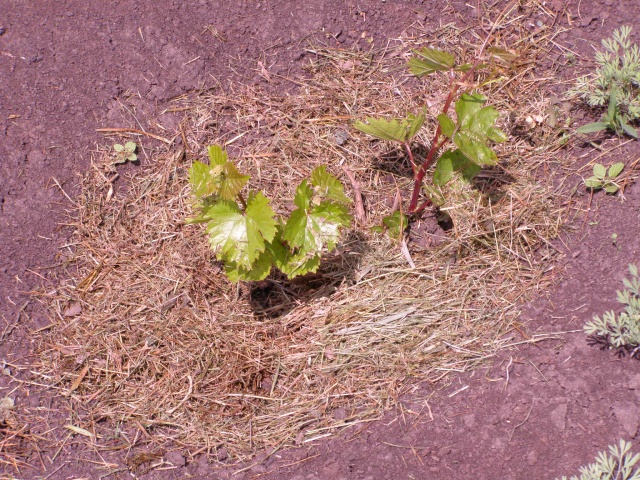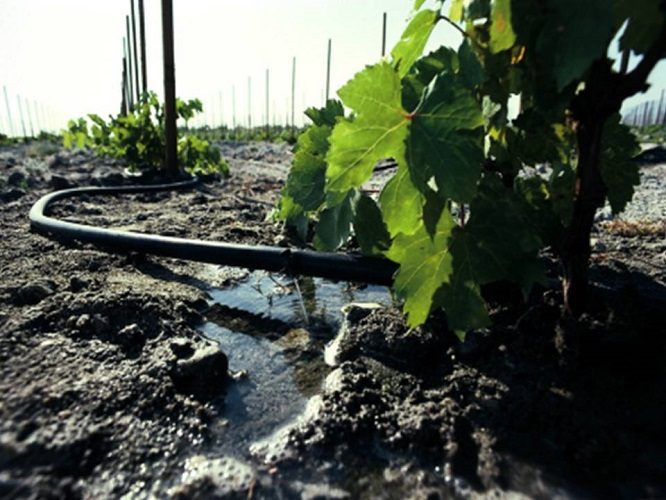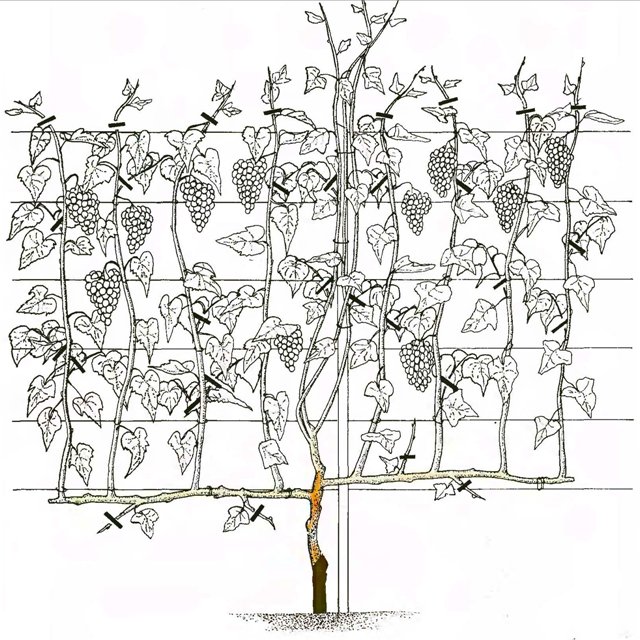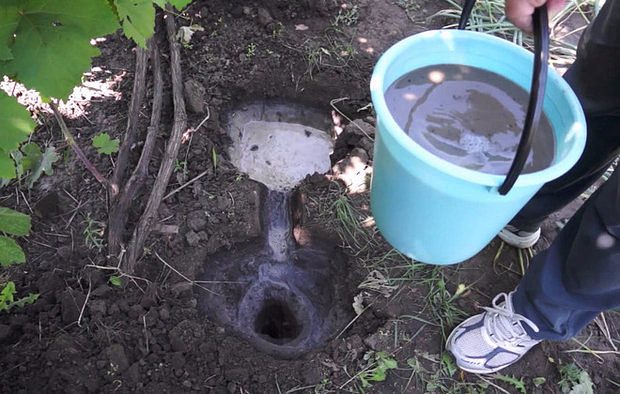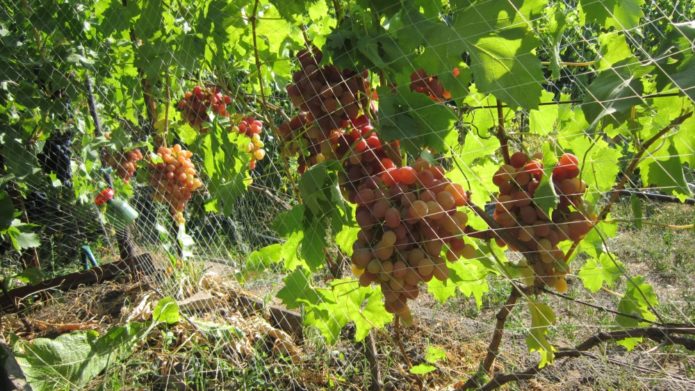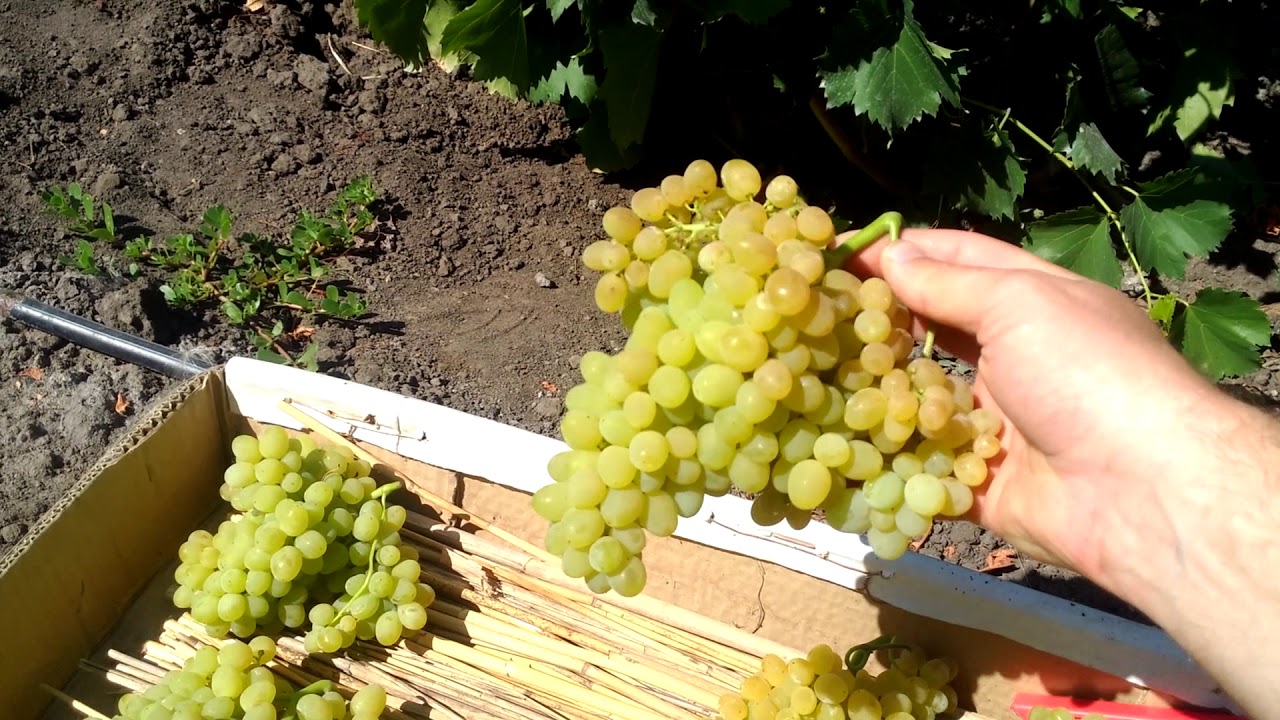The super early grape variety Julian has been known to many gardeners for several years as a hybrid with an amazing taste and a specific form of fruit. Juicy, aromatic and moderately sweet berries are good for compote and are good fresh. Surprisingly tender with light notes of strawberries, the fruits will please every gourmet, despite the presence of seeds in them, and will be a wonderful decoration for the festive table. Julian has adapted enough to the climatic conditions of Central Russia, it is considered a universal variety with high yields.
Content
Breeding history, description and characteristics of the Julian grape variety
A folk breeder from Rostov, Vasily Ulyanovich Kapelyushny, has developed more than 75 new grape varieties over the past 20 years, including hybrid forms. Another breeding experience - Julian - was presented to the public by the famous winegrower in the early 2000s. An early ripe hybrid combines:
- beautiful fruit color and excellent taste obtained from the table-raisin variety Rizamat with dark pink fruits, bred in sunny Uzbekistan;
- disease resistance and large-fruited - from the domestic hybrid Talisman (also called Kesha). The official name for the hybrid form is BH8.
Rizamat grapes are considered by many to be a forgotten exhibit, calling it “the yesterday of viticulture”. But is it worth neglecting the classics:https://flowers.bigbadmole.com/en/yagody/vinograd/vinograd-rizamat-opisanie-sorta-foto.html
Description of Julian grapes
Own-rooted hybrid (plant, the root part of which bears all the genetic characteristics of the selection variety) BH8 has great vigor and matures within 3 months. The berries ripen completely, gain enough sugar content in the last days of July - early August and acquire a lilac hue. The powerful vine carries the load well. A fairly developed root system is able to quickly accumulate carbohydrates and take root.
Important. Compatible with different rootstocks, the Julian variety can change its quality characteristics when grafted.
Video: grafting of the Julian variety on variety 16 1 White
The berry is dense, large (15–20 g), but more elongated than Rizamat fruits, in the shape of a finger. The average fruit size is 30 × 40 mm. When ripe, they are bright pink with yellow on top and reddish-lilac shades at the tip, unevenly colored. The pulp is crispy, tender, almost transparent, light green in color; the skin is easily eaten, without bitterness and astringency, rarely injured by wasps. There are 2–4 soft, underdeveloped bones. The harmonious taste is distinguished by nutmeg notes and a strawberry aftertaste. The color and taste of berries can vary depending on climatic conditions, temperature conditions and soil type. Dessert grapes are characterized by fast sugar accumulation (up to 28%) and do not crack.
The bunches are branched, large (from 25 to 40 cm), medium friable, in the form of a cone. Usually a bunch of Julian grapes has a long, strong stem, gaining weight from 800 g to 2 kg.
The plant develops bisexual flowers collected in dense conical panicle inflorescences. Each shoot has 2-3 inflorescences. The leaves of the hybrid are round, dark green, heart-shaped, five-lobed with a medium section. The denticles along the edge of the leaf are triangular; there is a slight pubescence of the underside of the leaf in the form of a bristle. The petiole leaves are open.
Shoots and petioles at the base have a brownish-red tint. The vine ripens along its entire length, even in the middle zone of our country, where there are temperature drops in summer, and autumn comes already at the end of August.
The Talisman grape is a variety that has long earned recognition, although it has not yet turned thirty years old. In the years of his birth, he became a kind of sensation, since there were very few such varieties with high resistance to frost and disease, fruiting with large tasty berries:https://flowers.bigbadmole.com/en/yagody/vinograd/vinograd-talisman-opisanie-sorta-foto-otzyivyi.html
Characteristics of the Julian variety
From the first flowering to the beginning of the ripening of Julian's berries, 95-105 days pass, the first bunches in central Russia ripen in early August, and in the Krasnodar Territory and Rostov Region, the first crop from Julian is taken at the end of July.
An interesting hybrid is also the fact that even at the beginning of September, a brush (second harvest) in each stepchild ripens on the vine, the main thing is that the weather does not disappoint.
The fruits of the hybrid retain their shape and do not lose their presentation for three weeks if stored at temperatures from +2 to +4 ° C.
The stem usually has 2-3 "sleeves" (branches carrying clusters), on each of which 3-4 powerful bunches are left - it is not recommended to overload the variety. Inflorescences and grape clusters are evenly distributed over the shoots, leaving the strongest clusters in the lower part of the vine, avoiding increased stress on the upper shoots. The vine grows up to 3-4 m.
To avoid overloading, gardeners are advised to do timely pinching of stepsons, whiskers and extra inflorescences.
The hybrid is pruned into 8-10 eyes (formations that unite the buds and help them grow), no more than 40-45 eyes remain on the vine.
The harvest of Julian grapes can be obtained not only from the central buds, but also from replacement (re-harvest). This is especially true when the main bud on the vine is "beaten" by late frosts.
A full harvest from one bush - 15–20 kg - is obtained in the third year. But the first signal clusters, by which one can safely determine the varietal characteristics of Julian, will appear in the second year.
The hybrid grows best on a lighted and well-ventilated southern or southwestern slope, away from trees and tall buildings that shade the vines. Depending on the weather conditions and climate, it will be useful to protect the vineyard from the northern winds with perennial shrubs and low-growing trees.
A powerful, vigorous plant develops well on a support, it is often grown as an arbor culture or along a fence (the distance to buildings is at least 1.5–2 m). With this planting, the vine ripens earlier and rarely freezes.
The Julian variety is characterized by winter hardiness, but requires shelter after autumn pruning, otherwise severe frosts will destroy the vine and central buds... Slate as a shelter is not suitable. It is necessary to use a covering non-woven material and a large amount of spruce or pine spruce branches. From above, you can already use slate or a shelter made of boards on a support, but be sure to leave ventilation, which can be arranged using cut plastic bottles.
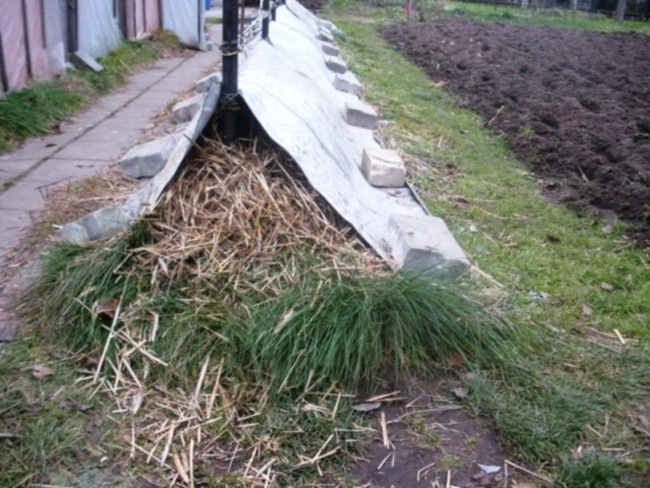
As a shelter for grapes for the winter, spruce branches or hay are suitable, closed on top with spunbond and slate
If moisture gets in, the vine may rot in the event of a prolonged rainy spring. This grape variety is responsive to watering, but does not tolerate dampness at all.
Video: characteristics of the Julian grape variety
Features of planting and growing grape varieties Julian
The culture is planted in open ground in the fall (in October) - in the southern regions, in the spring (before budding and sap flow) - in the Central Black Earth Region. In the first year of planting, a cultivated plant only needs watering and correct pruning of grapes in autumn... Top dressing is carried out starting from the second year of the growing season.
Landing
To exclude the shading of the boles and to ensure the warming up of the plot, the grapes are planted at a distance of 1.5-2 m between each seedling. It is recommended to plant grape bushes from north to south, observing the proximity of groundwater (no closer than 2 m). To avoid unnecessary accumulation of water in the planting pit, to which Julian is sensitive, the vine is planted on bulk ridges and hills. The grapes prefer fertile soil with a mild and neutral acidity level. To reduce acidity, lime is added (300 g per m22) or dolomite flour - 500 g per m22 .
The territory for planting grape ridges is prepared in advance. A year before planting, in areas with poor soil, measures are taken to restore the soil structure:
- in April, green manures are sown: legumes, mustard, oats (20 g of seeds per 1 m2);
- at the end of July - at the beginning of August, the green manure on the site is crushed with a rake, 50 g of potassium salt and 50 g of nitrogen fertilizers are applied, phosphorus-potassium fertilizers are mandatory - 150 g of superphosphate per 1 m2.
A few days before planting, the land is dug up on the site to improve air circulation. Grapes are planted in cloudy weather, in the afternoon, the daytime temperature should be above +12 ° C. If the gardener plans to plant 1-2 Julian grape bushes, prepare a planting pit; in the case when many plants grow in the vineyard, they dig trenches. In both cases, the planting principles are identical:
- A pit 80 × 80 × 100 cm is laid on the prepared site.
- Drainage - expanded clay, pebbles, fractions from walnut (10-15 cm) are poured on the bottom with a close occurrence of groundwater, a drainage pipe for irrigation (100 cm long and 6-7 cm in diameter) is installed next to it.
- A layer of fertile soil (humus + chernozem - 20 cm) is laid on top of the drainage mixture. Then make a mound in the form of a hill from a mixture of humus (2-3 kg), sand - half a bucket, black soil - 5-7 kg, 1 kg of ash and 50 g of superphosphate and potash fertilizers (on depleted soil - 100 g).
- The hole for grapes is thoroughly watered - 2 buckets of settled water at room temperature per plant.
- The seedling of the Julian hybrid is carefully lowered to the bottom of the pit, spread the roots over a mound and sprinkled with a fertile layer - humus and rotted manure - about 2 buckets. When planting, observe the direction of the vine: buds - to the north, root heel (the lower part of the seedling, from which the roots grow) - to the south). The required depth is no more than 40 cm (according to the selected grape planting pattern). The root space is not rammed to improve air exchange.
- The stem is tied up, the hole is sprinkled with mulch to retain moisture.
Preparing the planting pit necessarily includes uprooting stumps and removing the roots of weeds, stones that can damage the delicate root system of the seedlings. The depth and width of the hole may vary depending on the type of soil and the level of groundwater.
Watering
Young grapes and seedlings in the open field are watered every 2 weeks with water, the temperature of which is not lower than +20 ° C, preferably in the afternoon. Two-year-old grapes and older require abundant irrigation once a month - 5-6 buckets of settled water, in hot weather - every 10 days (late May - June). From mid-July, watering is reduced to ripen the vine and stop the growth of shoots.
The plant is watered at the root in a specially dug furrow 30–40 cm deep or with the help of a drainage hole, and if there are a lot of bushes, drip irrigation is used (plastic pipes are laid in the aisle with a branch to each stem through a “tee”). Leaves and shoots are not irrigated, natural precipitation is enough for them. The process of moistening the soil takes a long time, since the vine is watered as the previous portion of water is absorbed: this is due to the superficial location of the grape root system.
Video: drip irrigation of grapes
Pruning Julian variety
Bushes of a thermophilic culture begin to form only in the second year after planting. Julian grapes require timely pruning for effective fruiting and enhancing the nutrition of the vine. The thicker the vine, the longer it is cut. Spring pruning of grapes is aimed at forming a bush. When pruning grapes for fruiting in spring, the vine closest to the sleeve is cut into two buds. The second shoot is cut longer so that new fruit ovaries grow on it.
Pinching the upper shoots (chasing), removing stepchildren and whiskers in the summer accelerates the ripening of fruits and reduces the load on the plant.
Often, in June, banding (removal of the bark ring on the shoot) and twisting of the vine are carried out in order to accelerate the ripening of the crop.
Top dressing of early ripe grapes
In early spring, Julian's vine is watered with urea and infused chicken droppings.
The next top dressing consists in spraying the vineyard with complex preparations containing nitrogen, phosphorus and potassium, for example, Kemira. In wet weather, it is recommended to treat the bushes with a boric acid solution. As a root fertilizer, Azofoska is excellent - 50 g per 10 l of water.
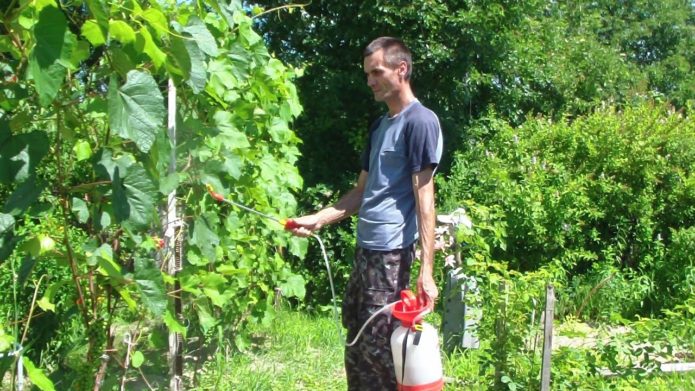
Foliar dressing of grapes is carried out with complex preparations containing nitrogen, phosphorus and potassium, for example, Kemira
After another 2 weeks, it is recommended to water the Julian grape vines with a solution of superphosphate 50 g, potassium salt - 30 g, boric acid - 5 g per 10 liters of water. Often, when feeding for the 2nd time, 5 g of potassium permanganate is added to the nutrient solution.
At the end of July, potash fertilizers are applied 2-3 times, which help to accelerate the sugar accumulation of fruits and ripening of the vine (under the root and along the leaf). In addition, homemade solutions are used: wood ash - 1 liter, boron - 3 g, chicken droppings - 2-3 kg to insist for two days, before adding, add 5 g of dry yeast and dilute the finished fertilizer in a ratio of 1 part of the nutrient solution to 5 parts of water ...
At the end of August, the application of nitrogen fertilizers is stopped.
Vineyard fertilization can be done through the same pipes that are used for drip irrigation. For this, fertilizer of the required concentration is added to the container.
What and how to feed the grapes at their summer cottage: https://flowers.bigbadmole.com/en/yagody/vinograd/chem-podkormit-vinograd-osenyu.html
Pest and disease control
Despite the assertion of experienced winegrowers that Julian is immune to fungal diseases and is not injured by insects, disease prevention will not be superfluous for a hybrid variety. The immunity of early ripe grapes is influenced by the varieties of powdery mildew - oidium and mildew, as well as anthracnose.
First of all, in April - May, the vineyard is sprayed with a solution of colloidal sulfur from oidium and Bordeaux liquid to fight fungal diseases.
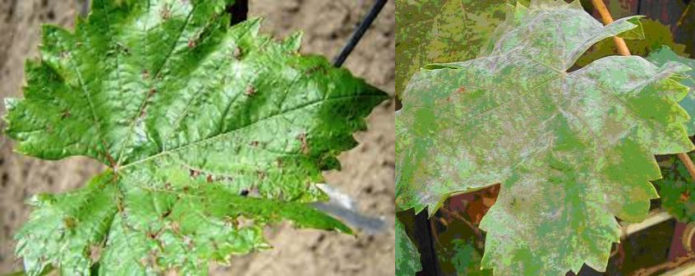
To prevent anthracnose (in the photo on the left), the vineyard is sprayed with Bordeaux liquid, and oidium (photo on the right) - with a solution of colloidal sulfur
For preventive purposes, grapes are treated with Hom, Horus, Ridomil Gold - at least three times per season. With a systematic examination of the bushes, diseased leaves and shoots are removed. Severe infection of the vine requires the immediate use of stronger drugs - Fundazol, Sumileks (according to the instructions). Such concentrated complex agents are treated before the beginning of fruiting. At the beginning of the appearance of ovaries, systemic herbal remedies are used - Falcon and Tilt.
The main pests of Julian's fruits are birds. To protect crops from them, gardeners use a polymer mesh.
Comparison of Julian grapes with similar ones, its advantages
The shape of the cluster of the early-ripening hybrid is very similar to the parent variety Rizamat, but Julian's berries are more elongated. Unlike the second parent - the Talisman variety - BH8 ripens 2–3 weeks earlier and is radically different in the shape and color of the fruit.
This variety is often compared with Krainov's Troika - the Victor, Preobrazhenie and Yubiley Novocherkassk varieties. The hybrid form Julian on a self-rooted plant ripens 5–12 days earlier than the similar variety Preobrazhenie. The bush is much more powerful and has a larger and denser berry, painted in a pale pink color than the reddish-brownish fruits of the hybrid form Victor - a variety very similar in appearance to the characteristics of the bunches and fruits on Julian.
The early ripening variety Julian has received the attention of many gardeners, is rightfully considered unique in terms of ripening and quality characteristics of the fruit.
Advantages and disadvantages of the variety - table
| Advantages | disadvantages |
| Frost resistant, withstands up to -24 ° С | Demanding to the degree of illumination plot on which it grows |
| Lack of pea in bunches | Sensitive to anthracnose |
| If damaged, berries dry out quickly, do not rot | Reacts to temperature changes during the growing season, reducing sugar content berries and bunch weight |
| High resistance to mildew and powdery mildew | |
| Unpretentious in the neighborhood with other varieties | |
| Drought tolerant |
In the case of grafting the hybrid Julian form on various varieties, the yield obtained may differ in qualitative and quantitative parameters. The experience of winegrowers shows that Julian lengthens its berries on Kesh, and grafted onto Lyana changes the shade of berries to a lighter pink.
Variety reviews
Julian and this year only pleases with a very good resistance to diseases, strength of growth, yield and has already begun to color! The bunches are large, the berry also continues to grow and increase in size. There was a very heavy downpour a week ago. The only berry burst that I continue to watch. The cracks do not rot, they just dry out, there are no berries baked in the sun either. The seedling is second year. Ripened simultaneously with Victor and Transfiguration. Good sugar production, crunchy taste, white-pink color. For another month I hung on a bush in a bag, it became sweeter.
For me, Julian is the closest in terms of maturation to the Transfiguration. The taste is slightly different from the latter, quite decent. In terms of yield, both are close, you just need to be more careful with the load. And if you load, then be sure to feed and water the bushes. By and large, Julian is very close to the Troika: outwardly, neither the leaf nor the crown are practically different; also willingly lays decent clusters on stepsons. Now on it and throughout the Troika, the berries on the stepsons have begun to color and have reached the size of the berries of a good Augustine, by October the second harvest of a decent size will be ready. A vineyard friend, having seen and tried YULIAN, asked me to give him 5–6 cuttings of this GF in the fall. He said that this is the best grape, but his Troika grows and bears fruit. Hence, the person caught the difference.
Wonderful berries of the Julian variety are not inferior in taste to table raisins. The unusual taste and shape of the fruit has long made the grape hybrid popular among many gardeners. It invariably remains the earliest and most delicious berry among the hybrids of recent years. If you do not neglect the peculiarities of cultivation, it will certainly become a long-liver on the site and will delight with delicious bunches already in early August.
